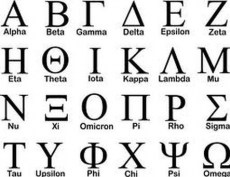
The Greek language might seem like a challenge, with its different alphabet and non-Latin sounding words. However, it’s a lot easier than you think. Greek is an older language than Latin – Latin being the language that helped create French, Italian, and Spanish (among others). As Greek is older, it had a really strong influence on the development of Latin, so although it doesn’t look similar to other European languages, many of our words come from Greek. If you’ve seen My Big Fat Greek Wedding, you’ll know what I mean – the father of the family, Gus, seeks to claim that every word in the English language comes from the Greek (including words like kimono – a clearly Japanese word)!
So, first things first, let’s take a look at the alphabet. The word ‘alphabet’ actually does come from the Greek – because ‘alpha’ and ‘beta’ are the first two letters of the Greek alphabet. The alphabet is the most important thing you’ll learn, as it means you can read and pronounce the words, plus really impress your friends.
Α/α = Alpha, or the letter ‘A’ in English.
Β/β = it’s technically ‘B’, but it’s pronounced more like the letter ‘V’. This one’s called Beta.
Γ/γ = nearly a ‘G’, pronounced softly, like ‘gh’. Its name is Gamma, like the gamma rays you learn about in Physics! Sounding familiar?
Δ/δ = technically ‘D’, but pronounced similarly to ‘th’. This one is called Delta.
Ε/ε = the letter ‘E’, said like ‘eh’. The name is Epsilon.
Ζ/ζ = This is the equivalent to the letter ‘Z’ in English, and it’s called Zeta, like Catherine Zeta Jones.
Η/η = Confusingly, this actually an ‘I’, pronounced more like an ‘E’, and its name is Eta.
Θ/θ = This is “th”, like the first two letters in the word “the”. This letter is actually called Theta, so it’s one of the simplest to remember.
Ι/ι = Another ‘I’, also pronounced like ‘E’. Its name is Iota, and this is where the letter names come in handy, because they help us with saying the letter right.
Κ/κ = This one is like the letter ‘K’ in English, and it’s called Kappa, like that sportswear brand.
Λ/λ = The equivalent to the letter ‘L’, this letter is called Lambda.
Μ/μ = the letter ‘M’, called Mu.
Ν/ν = This is an ‘N’, despite the lower case looking like a ‘V’. This one is called Nu.
Ξ/ξ = The closest thing to the letter ‘X’ in English, this one is pronounced “ks”, and is called Ksi.
Ο/ο = Basically the letter ‘O’, called Omicron.
Π/π = This is the English letter ‘P’. You might recognise this one from GCSE maths – it’s called Pi!
Ρ/ρ = Weirdly, this is the letter ‘R’ in English, despite both cases looking like a ‘P’. Its name is Ro.
Σ/σ/ς = These three are all the letter ‘S’. The first is the capital letter, the last is only used at the end of a word, and the middle one fills everything else in between. These are called Sigma.
Τ/τ = The letter ‘T’, with the name of Tau.
Υ/υ = Yet another ‘I’, although closer to the English letter ‘Y’. It’s called Upsilon.
Φ/φ = the equivalent to the letter ‘F’, called Phi.
Χ/χ = this makes a ‘ch’ sound, despite looking like an ‘X’. This one’s called Chi.
Ψ/ψ = The ‘ps’ sound, called Psi. For those of you who know a bit about Greek Gods, this one looks a bit like ocean god Poseidon’s trident, so if you remember that and Poseidon you’ll remember it’s the “ps” sound.
Ω/ω = The last letter of the alphabet, basically another ‘O’, called Omega.
Image from: http://www.wtpanhellenic.com/greek-alphabet.html

0 Comment:
Be the first one to comment on this article.